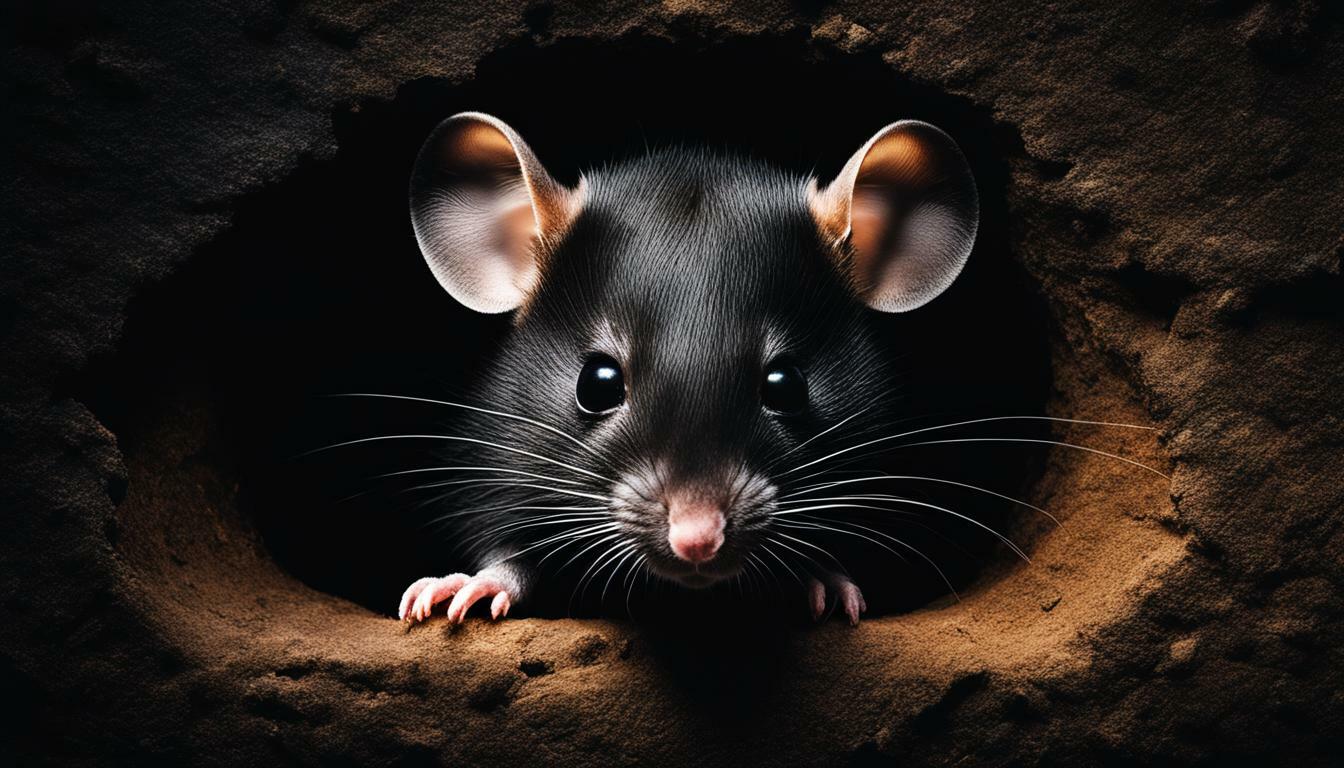Have you ever wondered if mice can be black? Let’s find out! Mice, like many other animals, come in a wide range of colors, including black. However, there is no distinct species known as black mice. Instead, house mice, which are commonly found in homes, can exhibit fur that ranges from brownish to light gray, dark gray, or even nearly black. In this article, we will explore the different color variations of mice, including black-colored mice, and delve into the genetics behind black fur in these small rodents.
Key Takeaways:
- Mice can come in a variety of colors, including black.
- There is no specific species known as black mice.
- House mice, commonly found in homes, can have fur ranging from brownish to nearly black.
- Mice infestations should be dealt with by contacting a pest control professional.
- To prevent mice infestations, eliminate attractants, seal off entry points, and maintain a clean environment.
Understanding Mouse Color Variations
Mice, despite being commonly associated with gray or brown fur, can actually exhibit a wide range of colors, including black. These color variations are influenced by genetics and can be fascinating to explore. Let’s dive into some interesting facts about black mice and their genetics.
Black mice, also referred to as melanistic mice, possess a coat color that appears incredibly dark, often resembling black. This coloration is a result of an increased production of melanin, the pigment responsible for fur color. Melanistic mice have a genetic mutation that causes overproduction of melanin, giving them their distinct black fur.
It’s important to note that while there is no specific black mouse species, house mice, which are commonly found in homes, can have fur that ranges from brownish to light gray, dark gray, or nearly black. This variation in fur color is due to different genetic combinations within their population.
The Genetics of Black Mice
The genetics behind black mice are complex and fascinating. These animals have specific genes that control the production of melanin, such as the Mc1r gene. Mutations in these genes can lead to increased melanin production, resulting in a black coat color. Scientists have been studying the genetics of black mice to better understand how these genes function and how they contribute to fur coloration.
In addition to genetics, environmental factors can also influence the color variations in mice. Factors such as diet, temperature, and exposure to light can affect the expression of certain genes involved in fur color production. This further adds to the intriguing nature of mouse color variations.
| Key Points: |
|---|
| – Mice can exhibit a wide range of colors, including black. |
| – Black mice, or melanistic mice, have a genetic mutation that causes increased melanin production. |
| – House mice can have fur that ranges from brownish to light gray, dark gray, or nearly black. |
| – Genetics and environmental factors contribute to the color variations in mice. |
Melanistic Mice and Black Fur
Melanistic mice are a fascinating variation, as they possess a genetic mutation that leads to a dark, black-like coat. This mutation affects the production of pigment in their fur, resulting in a rich and intense black coloration. These mice are often mistaken for a distinct species, but they are actually a color variation within the house mouse population.
The genetic basis for melanism in mice is complex and still not fully understood. It involves alterations in the production and distribution of melanin, the pigment responsible for the coloration of skin, hair, and fur. Melanistic mice have an excess of melanin, which causes their fur to appear black, sometimes making it difficult to distinguish individual hairs.
It is important to note that melanistic mice are not uniformly black. Under certain lighting conditions, their fur may appear dark brown or even gray. This variation in color is due to the way light reflects off their fur and the individual variations in melanin distribution. Nevertheless, melanistic mice are undoubtedly striking to observe, with their deep, dark fur that sets them apart from other color variations of house mice.
| Melanistic Mice Characteristics | Description |
|---|---|
| Coat Color | Dark brown to black |
| Hair Texture | Thick and lustrous |
| Eye Color | Usually dark, varying shades of brown |
| Distribution | Global, found in various habitats |
Melanistic mice are a natural variation that adds to the diversity within the house mouse population. Their unique appearance and genetic makeup make them an intriguing subject for genetic and evolutionary studies. By understanding the mechanisms behind melanism in mice, scientists hope to gain insights into the broader field of genetic variations and adaptations in mammals.
House Mice and Color Range
House mice, commonly found in residential settings, can display a spectrum of fur colors, including shades that closely resemble black. While not a distinct species, the color variations of house mice can range from brownish to light gray, dark gray, and even nearly black. This diversity in color adds to the intrigue and charm of these small rodents.
Understanding the color range of house mice is fascinating. Their fur color is determined by a combination of genetics and environmental factors. Different genes control the production of pigments that give rise to various colorations. Some mice may have genes that produce darker pigments, resulting in fur that appears black. These mice, although not entirely black, can be mistaken for black mice due to the intensity of their color.
In addition to genetics, the natural environment can influence the color of house mice. Mice living in darker habitats, such as forests or underground burrows, may have darker fur to provide better camouflage and protection from predators. This adaptation allows them to blend in with their surroundings and enhances their chances of survival.
| Fur Color | Description |
|---|---|
| Brownish | Shades of brown resembling the color of wood or soil. |
| Light Gray | Soft gray hues with a subtle sheen. |
| Dark Gray | Deeper gray shades that border on charcoal. |
| Nearly Black | Fur that is extremely dark, often mistaken for black. |
It is crucial to address mice infestations promptly as they can cause significant damage to property and potentially carry diseases. Seeking professional help from pest control experts is recommended to effectively manage these infestations. Implementing preventive measures such as eliminating food and shelter sources, sealing entry points, and maintaining cleanliness can help minimize the risk of mice entering your home.
Dealing with Mice Infestations
While black mice may not be a distinct species, it is crucial to address mice infestations promptly to prevent damage and potential health risks. House mice, which are commonly found in homes, can have fur ranging from brownish to light gray, dark gray, or nearly black. These small rodents can cause extensive damage to property by gnawing on wires, furniture, and insulation. Additionally, they are known to carry diseases such as hantavirus, leptospirosis, and salmonellosis, posing a risk to human health.
If you suspect a mice infestation in your home, it is recommended to seek professional help from a pest control expert. These professionals have the knowledge and experience to effectively eliminate the infestation and prevent future occurrences. They will conduct a thorough inspection to identify the extent of the infestation and implement appropriate control measures.
Preventing mice infestations requires eliminating attractants and securing your home against these pests. Start by sealing off any entry points, such as gaps in walls, doors, and windows, with steel wool or caulk. Keep your home clean and tidy, as mice are attracted to food and clutter. Store food in airtight containers, dispose of garbage regularly, and clean up spills promptly. It is also essential to address any moisture issues, as mice are drawn to damp environments.
| Preventive Measures for Mice Infestations |
|---|
| Seal off entry points with steel wool or caulk |
| Keep your home clean and tidy |
| Store food in airtight containers |
| Dispose of garbage regularly |
| Clean up spills promptly |
| Address moisture issues |
By following these preventive measures and seeking professional assistance when necessary, you can effectively manage and prevent mice infestations in your home. Remember, early intervention is key to minimizing the potential damage and health risks associated with these unwanted guests.
Conclusion
In conclusion, mice can come in black as part of their diverse color variations, but there is no separate species solely consisting of black mice. House mice, which are commonly found in homes, can have fur that ranges from brownish to light gray, dark gray, or even nearly black.
Dealing with mice infestations can be problematic, as they can cause damage to property and carry diseases. It is important to seek the assistance of a pest control professional when faced with a mice infestation. They have the expertise and knowledge to effectively eliminate the infestation and prevent future occurrences.
To prevent mice infestations, it is crucial to eliminate attractants that can entice them to your home. This includes sealing off entry points, keeping the environment clean, and removing potential food and shelter sources. By taking these preventive measures, you can greatly reduce the risk of mice entering your living space.
Remember, while black-colored mice may be a part of the natural color variations in mice, infestations should not be taken lightly. Taking proactive steps to prevent infestations and seeking professional help when necessary can help ensure a safe and pest-free home environment.
FAQ
Can mice be black?
Yes, mice can come in a variety of colors, including black. While there is no distinct species known as black mice, house mice, which are commonly found in homes, can have fur ranging from brownish to light gray, dark gray, or nearly black.
What causes black fur in mice?
The presence of black fur in mice is often the result of a genetic variation called melanism, which causes an abundance of the pigment melanin in their fur.
Are there specific black mouse species?
No, there are no specific black mouse species. The black coloration in mice is part of their natural color variations, and house mice, which are the most common type found in homes, can exhibit black fur.
Can mice infestations be problematic?
Yes, mice infestations can be problematic as they can cause damage to property and carry diseases. It is important to contact a pest control professional to deal with mice infestations.
How can I prevent mice infestations?
To prevent mice infestations, it is important to eliminate attractants such as food and shelter, seal off entry points that mice can use to enter your home, and keep the environment clean and tidy.
What is the color range of house mice?
House mice can have fur ranging from brownish to light gray, dark gray, or nearly black. While they are not a distinct black mouse species, some house mice can exhibit black fur.




